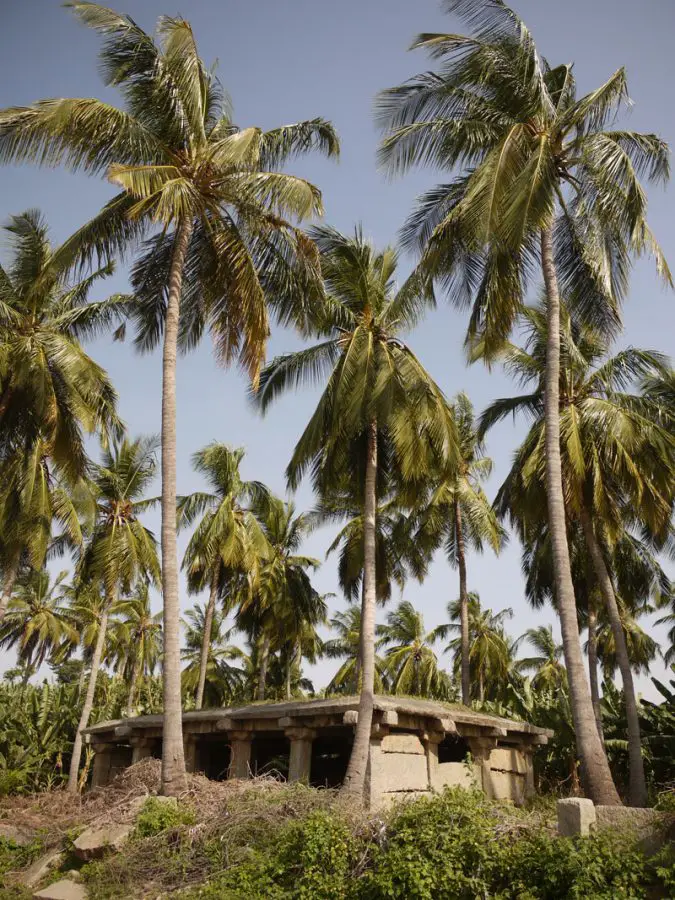Auto-rickshaws have almost been a way of life for us in India, whether it’s been dodging them in the busy bazaars or risking our lives in them getting from a to b, they’ve been an integral part of our Indian experience thus far. Jumping off the train in Hospet we had to take yet another ‘rick’, from the town to our destination, Hampi, but this time it would be with a difference. Chatting to our driver on the winding country roads zipping past colourful temples and lush rice fields he asked us “have you ever driven a rickshaw?”, to which we replied “no, but it looks like fun”, “okay you drive” and with that he pulled in, pushed over in his seat and one by one let us take the ‘wheel’ (more like handlebars!). We took turns driving the little auto towards Hampi, teasing it through the corners and pulling the throttle back a little more as our confidence grew. Eventually, after a quick photo shoot driving the tuk-tuk, we came up over the hill and laid eyes on one of the most unique landscapes we had ever seen. Ancient temples and huge boulders were strewn across the rolling green hills with seemingly no rhyme or reason. Nestled between banana plantations, the enormous boulders seemed to just balance perilously along the carpeted green hills reminding us of a set from ‘The Flinstones’. All we needed was for Fred and Wilma to come around the corner roaring yaba-daba-doo and the scene would have been complete!
We reached what used to be the main bazaar but it was far from the lively scene that we were told it once was. The Archaeological Survey of India came in only twelve months ago and demolished all the guest houses, shops and restaurants forcing all businesses to close and relocate to the new bazaar a block back. Locals told us the reason for this was that they were asked to stop building but due to certain businesses ignoring the pleas from the Archaeological Survey to stop expanding into the street, everything was demolished. Sadly, the main bazaar looks like a construction site with half-demolished buildings and rubble just left on the sites where the buildings used to stand.
Some locals have chosen to relocate to the surrounding jungles where they live in self-built shelters and have to resort to a life of agriculture which is a lot less prosperous than the tourist industry. Others stay in the ruined buildings, squatting amongst the rubble where their business once stood. Locals told us how in ten years time the new bazaar, where those businesses which could afford to set up again did so, will also be demolished by the Archaeological Survey of India and what’s more is all the small villages in the locality and their populations will be forced to move out of the area as it is becoming a fenced off protected zone due to the archaeological interest here. It’s heart-wrenching to listen to the locals stories of how their homes and livelihoods are being taken away from them and from a tourists point of view this new arrangement won’t allow the Hampi experience to be quite the same.
With Hampi becoming a protected area, tourists will have to visit on day trips from Hospet and no longer will be able to stay in the shadows of the massive temple stretching into the sky like a mountain from the top of the ruined bazaar or walk freely through the Flinstone-like landscape and really soak up the laid-back vibe of this unique and amazing place. It’s a true shame that experiences such as walking through banana plantations, watching the temple elephant turn in for the night, watching kids cross the river in weaved baskets and watching the sun set over an indescribable landscape will be lost to generations of future travellers.
Scattered all around Hampi are ancient buildings, monuments and temples dating as far back as 1442, rightfully earning Hampi it’s place as a UNESCO World Heritage Site. Renting a small motorbike for the day we set out exploring the ancient ruins. The 16th century Vittala Temple was to be our first port of call and Hampi’s most famous complex didn’t fail to impress us. Walking through the giant stone gate we found ourselves in a huge stone courtyard and welcoming us was one of Hampi’s most well-known sculptures, the ornate stone chariot whose wheels were once capable of turning. Beyond the chariot is the focal point of the complex, a square temple building complete with ‘musical’ pillars which hit various notes when tapped. Throughout this central building and the nearby pavilion style structure are beautiful carvings and sculptures of gods and mythological creatures etched into the walls and pillars of the buildings. Just outside the complex is an old, deserted bazaar lined with columns and the King’s Balance used for weighing various goods and livestock. Distracted for a minute by wild horses running
through the green jungle in front of us we made our way back to our little chicken chaser bike and headed towards the next complex, the Royal Centre. Not far inside the walls of the Royal Centre is the fabulous Lotus Mahal, fit for royalty it’s thought this pavilion was once the Queen’s recreational mansion. Through another gap in the huge stone walls, which were created using ‘shaved’ boulders and we were outside the royal elephant stables; not two words you hear together everyday back home! The domed building is fronted by eleven massive archways, each representing a single stable and it’s quite a structure with even the inside decorated with beautiful carvings. Travelling back toward the main bazaar we passed even more temples, shrines and monuments all from this same era and each one is as impressive as the last. As dusk was rolling in we pulled up at the foot of Hemakuta Hill which we walked up beyond the gigantic monolithic Nandi statue and up to the where we could look straight down the line of the old main bazaar. From here, we sat down, doing our best to avoid the eight inch long millipede type things which were crawling out from beneath the rocks. Beyond the 50 metre high spire of the Virupksha Temple at the far end of the bazaar we watched in silence as the sun dropped from the sky like a glowing hot ball and brought to an end another memorable day.
The following day brought about a real highlight of our trip to Hampi. Taking the small tin boat across the river and exploring the little villages on the far side of the river we got to explore the surrounding area for what it is without worrying about getting all the sights and tourist attractions in. On crossing the river safely we rented bicycles and spent the day exploring the beautiful countryside.
The terrain was more green than we had been used to for the last few weeks and it was great to be out in such lush, undeveloped countryside. As we cycled by we watched men and women working hard in the fields with the shadows of thatched cottages providing some shelter for them from the hot sunshine. Tractors, motorcyclists and other cyclists waved happily as we pedalled by on the quiet roads winding around temples, rice fields and banana plantations. After cycling for some time we reached the ancient fortified village of Anegundi, also a part of the Hampi World Heritage Site.
A real local vibe existed here, the streets were busy with ox drawn carts, goats being herded along and women balancing bales of grass on their heads. Our timing couldn’t have been better with all the school children filing out into the streets, adding to the excitement of our arrival. Two girls even hitched a ride home with us, jumping on the back of our carriers and directing us which way to go between fits of giggles and after dropping them off at their house and posing for a few photos (with our camera) we were on our way back towards the river where we would take a boat back to Hampi and then a late night rickshaw ride to Hospet to continue our travels into a completely different environment, India’s metropolitan city, Mumbai.

Brian is a travel writer, photographer, blogger, travel addict and adventure-junkie. Being outdoors, getting off the beaten track and outside his comfort zone is what makes him tick. Brian’s the dreamer in the relationship; when he’s not travelling, he’s dreaming about it! Keeping fit, cooking, music and red wine take up the rest of his time.
Sign up for our free travel photography Ebook "Faces of Nepal" and you'll also receive our monthly newsletter.












